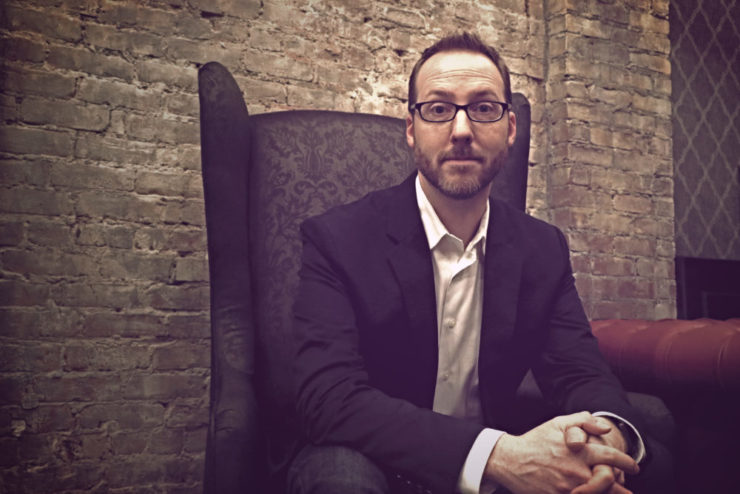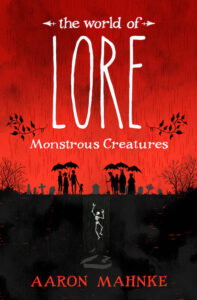Barely three years ago, Aaron Mahnke, a part-time horror-thriller writer, sat at his computer and started to drag a document to the trashcan. Just as he was about dispose of the sprawling essay he’d written with outtakes from his supernatural research, he paused, letting the document hover by the can. He thought: "Well, Aaron, you listen to audiobooks -- that's how you read. So maybe you could at least turn these into little audio essays.”
That momentary hesitation changed his life. Just a few months later, Mahnke launched “Lore” -- a podcast about true-life scary stories.
"In a lot of ways, yeah, I’m that kindly docent, but in the end, it’s all about trust. I need to earn the trust of the listener so that they’ll follow me deeper into the dark tunnel."
Since then, he’s collected an audience of millions, an agent, a multiple book deal and an Amazon Prime TV show featuring his work. Last year, “Lore” was named one of The 10 Best Podcasts by Entertainment Weekly and one of The 50 Best Podcasts by The Atlantic.
The podcasts typically open with some bars of eerie-lonely piano music followed by Mahnke’s wise-older-brother voice establishing a neutral premise. For example, at the outset of Episode 37: “Passing Notes,” he pronounces: “We live in a crowded world. As of this episode, the U.S. Census Bureau puts the number of human lives on this pale blue dot of a planet at around 7.3 billion.”
From there, Mahnke eases us into the idea that our homes are refuges from the masses, “where strangers are not allowed in without an invitation.” Over the next half hour that innocuous dependent clause will become more and more ominous, but in his openers, Mahnke likes to dim the lights gradually, hinting at what’s to come, rather than plunging us straight into the heart of “historical events that show the dark side of human nature.”
Episode 37 focuses on the Spiritualism movement -- a phenomenon that took hold in the mid-1800s whose followers held séances to communicate with the dead. Mahnke says believers found hope in discovering “a new door” to the afterlife. But, lest listeners think this to be a breezy lecture on an ancient fad, Manhke foreshadows what’s ahead in a voice decidedly grave: “Some doors, you see, are closed for a reason.”
Only after casting out his softly provocative auditory nut graf does the host introduce himself with a sober: “I am Aaron Mahnke, and this [pause for effect] is ‘Lore.’”
In the “Passing Notes” episode, Manhke shares the story of two sisters in grade school from upstate New York who began acting as mediums conveying messages from the beyond. Then he cites anecdotes about Spiritualism's believers, among them Sir Arthur Conan Doyle and Charles Dickens, and skeptics, such as Harry Houdini. Then he skips forward to share an account of a two people in Michigan who conduct a beyond-the-grave communication experiment in the 1920s.
And then, having teased our interest with noir-ish trivia, Mahnke settles in to recount the biggest story of the episode. Using techniques from the thriller playbook, first Mahnke narrates what happened—a family in Connecticut comes home one day in 1850 to find their house torn apart, as if by vandals, but nothing missing, and bizarrely, life-size ragdolls made from their clothing occupy in the bedroom and dining room.
“It was a lot to take in,” Mahnke sympathizes. As time goes on, kooky messages written in messy handwriting and signed by the devil drift through the house’s rooms. Next, Mahnke offers perhaps why all heck’s broken loose: A week before the spiritual home invasion, the father had conducted a séance to reach someone in the afterlife, thereby “opening the door” and unwittingly issuing an invitation to this stranger’s mayhem.
On Friday the 13th of this month, a six-episode TV series of "Lore" launched on Amazon Prime. Created in partnership with producers of “The Walking Dead” and “The X-Files,” Mahnke’s accounts of malevolent ghosts, as well as vampires, werewolves and body snatchers, are brought to life through a mash-up of animation, dramatization performed by actors in period costume and use of archival documentary footage. Listeners can now experience the content of Episode 37 repackaged and enacted in Episode 4 the TV series, also called “Passing Notes.”
"I try to go into these stories with an open mind and without bias. Story is better served when the reader or listener can make their own decisions about what to believe. I want to honor the story itself, and leave all of the other stuff open."
Although Mahnke provides a voice-over to set up the narrative, once the drama is underway, prefaced by the message that all the stories are based on real people and actual events, his presence is undetectable. Viewers simply as watch the actors portray the ghastly scenes. Whereas the podcast featured Mahnke’s endearing understatement as the Connecticut family encounters their ransacked home (“it was a lot to take in”), the viewer experiences the horrified faces of a family who discover that a stranger has entered their home and left a life-size ragdoll, its arms crossed in a corpse pose, in the parents’ bed. (Speaking of beds, I refuse to watch or listen to "Lore" while I’m in mine.)
If listening to podcasts and TV shows of Mahnke’s dark dramas aren’t enough, Mahnke’s book “The World of Lore: Monstrous Creatures,” came out this month. And just in time for Halloween, Mahnke has been on a U.S. tour offering live performances, “a night of stories guaranteed to entertain, educate, and thrill.”
From the beginning, Mahnke, a native of Illinois who now lives in Danvers, Mass., had two goals for his show: “[1] to tell the historical facts behind common scary stories in a deeply narrative way, and [2] to keep each episode short and professional, with a palpable mood and audible polish.”
As a result, each biweekly episode is an auditory essay that combines medical, social and psychological history with folklore and anthropology to create one heckuva creepy chronicle.
As a self-described a nerd for anything supernatural or unexplainable, how do you and your research assistant, Marcet Crockett, navigate or vet your research? In this murky realm where lore and malarkey might be Siamese twins, how do you decide what makes the cut for inclusion in an episode? How do you wield a healthy skepticism when your subject matter sometimes defies fact-check-ability?
You know, the research phase is one of the most fun for me. There are so many rabbit trails and pathways to take, and I get to just sort of revel in the story as it unfolds. But that’s also a bad thing, as I’ve discovered that my context-focused mind has a tendency to get off topic and follow all of those leads.
That’s where my research team comes in (Marcet and Carl [Nellis]). They go off and chase down the best sources for me to start with, and they outline the major events or bios so that I can hit the ground running -- and focused! -- when I begin my time with the topic.
But this is history, and you have to walk in assuming that history can be fuzzy or unclear at times. And that’s OK. Folklore isn’t a straightforward path, anyway; it’s more like the meandering roots of an old tree. I just follow things where they lead me, and try my best to tell the truth along the way.
"Lore" (both the audio podcast and the Amazon TV show) documents ancient cultural and archetypal ideas and then traces ways in which they continue to haunt/intrigue us in the modern age, intellectually exploring intense emotional subject matter. Are there any episodes (either audio or TV) that feel particularly personal to you, that connect to your experiences growing up? And if so, is that personal connection a hindrance or an asset?
Nothing that really stands out as “familiar” to my growing-up years, but there’s the overall love for odd and unusual tales. I think you see that more in the episodes that focus on creatures or spirits, but it’s there to some degree in every episode.
I try to go into these stories with an open mind and without bias. Story is better served when the reader or listener can make their own decisions about what to believe. I want to honor the story itself, and leave all of the other stuff open.
What is one of the strangest or unexpected resources or archives you've consulted on behalf of Lore?
Nothing strange or unusual, honestly. Just lots and lots of books!
As Lore's narrator, your voice is steady and even; you sound authoritative (in a friendly way) as you lead us into horrifying, bizarre, and/or disturbing stories -- is that a conscious decision? Do you intentionally offer an emotionally neutral presence to offset the material, perhaps as comedian tamps down her own amusement to earn the audience's laugh?
I’m a tour guide, and I want to lead my audience toward the payoff. So in a lot of ways, yeah, I’m that kindly docent, but in the end, it’s all about trust. I need to earn the trust of the listener so that they’ll follow me deeper into the dark tunnel. So I won’t be overly dramatic, and I might toss in a bit of humor to disarm people and help them rest easy. Whatever it takes to keep them following my lead and get them to the end.
How do you calculate the attention span of the Lore listener and [how] do you strategically plot out an episode to retain that listener?
I built "Lore" around my own attention span, although I think I did it subconsciously. I never really thought about it. I’m just making the storytelling experience that I would want to listen to, and that’s roughly 25-30 minutes for me. I think, after almost three years, I’ve discovered that it’s actually the sweet spot for most listeners.
And the story is better served by being concise. I don’t have to spend too long on a particular detail, so there’s no room for boredom. I prefer to move efficiently through the story.
Episode Six of the "Lore" TV series on Amazon Prime explores the things we bring to life through our imagination -- especially dolls. What is it like to experience the tremendous success of your imaginative project?
This is a dream come true. Especially for a storyteller. I get to take these tales and present them in different mediums -- audio, visual and print -- and let new audiences enjoy them in their own way. The story has become the star, and that makes me very happy.




